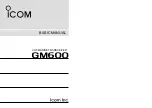
EN
Specifications:
• Type: DSM Full Range Receiver
• Channels: 6
• Modulation: DSM2, DSMX
• Dimension (WxLxH): .85 x 1.19 x .48 in (26.6 x 30.1 x 12.3mm)
• Weight: 26 oz (7.5 Grams main receiver)
• Input Voltage Range: 3.5–9.6V
• Resolution: 2048
• Compatibility: All DSM2 and DSMX Aircraft Transmitters and Module Systems
• Single receiver capable (can be used with or without the included Remote
Receiver, note that the AR6210 is limited to park flyer aircraft only when
not using the remote receiver).
• Flight Log compatible
• Telemetry compatible
Receiver Installation
The AR6210 incorporates dual receivers, offering the security of dual path RF redundancy. An
internal receiver is located on the main PC board, while a second external receiver is attached to
the main board with a 6-inch extension. By locating these receivers in slightly different locations in
the aircraft, each receiver is exposed to its own RF environment, greatly improving path diversity
(the ability for the receiver to see the signal in all conditions).
Antenna Polarization
For optimum RF link performance it’s important that the antennas be mounted in an orientation
that allows for the best possible signal reception when the aircraft is in all possible attitudes and
positions. This is known as antenna polarization. The antennas should be oriented perpendicular to
each other; typically vertical and horizontal and at different angles (see Receiver Installation below).
The remote receiver antenna should be mounted in a position perpendicular at least 2 inches away
from the main receiver’s antenna using double-sided foam tape.
Receiver Installation in Aircraft
In gas and glow aircraft install the main receiver using the same method you would use to install
a conventional receiver in your aircraft. Typically, wrap the main receiver in protective foam and
fasten it in place using rubber bands or hook and loop straps. Alternately, in electric airplanes
or helicopters, it’s acceptable to use thick double-sided foam tape to fasten the main receiver in
place. Mounting this remote receiver in a slightly different location, even just inches away from the
primary receivers, gives tremendous improvements in path diversity. Essentially, each receiver sees
a different RF environment and this is key to maintaining a solid RF link, even in aircraft that have
substantial conductive materials (e.g. larger gas engines, carbon fiber, pipes, etc.), which can weaken
the signal. Using servo tape, mount the remote receiver keeping the remote antennas at least 2 inches
away from the primary antennas. Ideally, the antennas will be oriented perpendicularly to each other.
In airplanes, we’ve found it best to mount the primary receiver in the center of the fuselage on the
servo tray and to mount the remote receiver to the side of the fuselage or in the turtle deck.
In helicopters, there is generally enough room on the servo tray to achieve the necessary separation.
If necessary a mount can be fashioned using clear plastic to mount the external receiver.

























